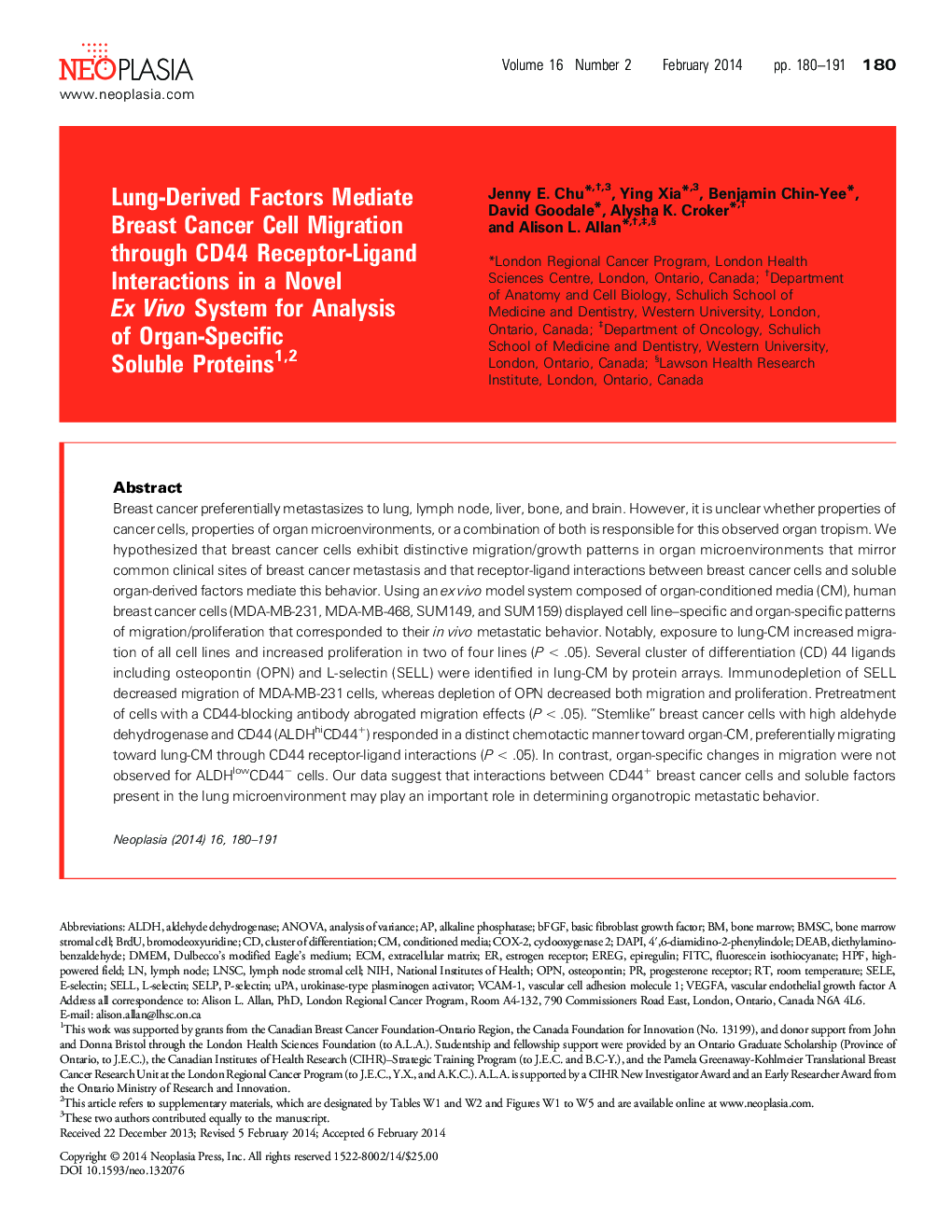| Article ID | Journal | Published Year | Pages | File Type |
|---|---|---|---|---|
| 2151437 | Neoplasia | 2014 | 18 Pages |
Abstract
Breast cancer preferentially metastasizes to lung, lymph node, liver, bone, and brain. However, it is unclear whether properties of cancer cells, properties of organmicroenvironments, or a combination of both is responsible for this observed organ tropism. We hypothesized that breast cancer cells exhibit distinctive migration/growth patterns in organ microenvironments that mirror common clinical sites of breast cancer metastasis and that receptor-ligand interactions between breast cancer cells and soluble organ-derived factors mediate this behavior. Using an ex vivo model system composed of organ-conditionedmedia (CM), human breast cancer cells (MDA-MB-231,MDA-MB-468, SUM149, and SUM159) displayed cell line-specific and organ-specific patterns of migration/proliferation that corresponded to their in vivo metastatic behavior. Notably, exposure to lung-CM increased migration of all cell lines and increased proliferation in two of four lines (P < .05). Several cluster of differentiation (CD) 44 ligands including osteopontin (OPN) and L-selectin (SELL) were identified in lung-CM by protein arrays. Immunodepletion of SELL decreased migration of MDA-MB-231 cells, whereas depletion of OPN decreased both migration and proliferation. Pretreatment of cells with a CD44-blocking antibody abrogated migration effects (P < .05). “Stemlike” breast cancer cells with high aldehyde dehydrogenase and CD44 (ALDHhiCD44+) responded in a distinct chemotacticmanner toward organ-CM, preferentially migrating toward lung-CM through CD44 receptor-ligand interactions (P < .05). In contrast, organ-specific changes in migration were not observed for ALDHlowCD44- cells. Our data suggest that interactions between CD44+ breast cancer cells and soluble factors present in the lung microenvironment may play an important role in determining organotropic metastatic behavior.
Keywords
uPAVEGFAhpfBMSCNIHOPNE-selectinP-selectinVCAM-1DAPIL-selectinEpiregulinDEABSELPEREGSELLdiethylaminobenzaldehydeECMALDHCOX-2DMEMFITCbFGFaldehyde dehydrogenaseAlkaline phosphataseOsteopontineleBrdUbromodeoxyuridineanalysis of varianceANOVAcluster of differentiationRoom temperatureconditioned mediaBone marrow stromal cellcyclooxygenase 2Vascular endothelial growth factor Abasic fibroblast growth factorurokinase-type plasminogen activatorfluorescein isothiocyanateNIH, National Institutes of HealthExtracellular matrixbone marrowVascular cell adhesion molecule 1Lymph nodeEstrogen receptorProgesterone receptor
Related Topics
Life Sciences
Biochemistry, Genetics and Molecular Biology
Cancer Research
Authors
Jenny E. Chu, Ying Xia, Benjamin Chin-Yee, David Goodale, Alysha K. Croker, Alison L. Allan,
